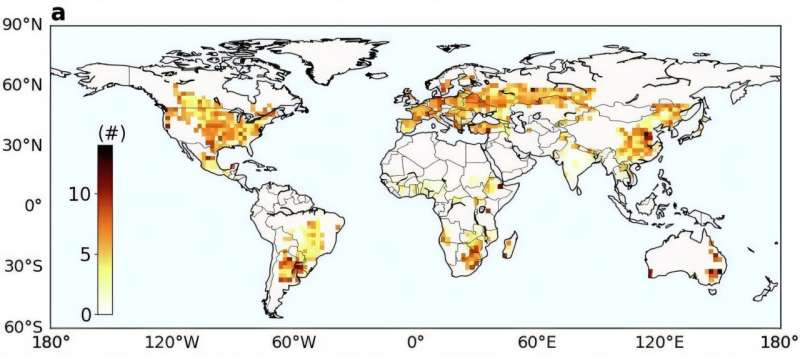A recent study from the University of California – San Diego has unveiled a significant factor influencing the vulnerability of global crops: the origin of rainfall. Published in Nature Sustainability on November 8, 2025, the research highlights how understanding whether rainfall comes from ocean or land sources can enhance drought risk predictions for farmers.
The authors of the paper, “Crop water origins and hydroclimate vulnerability of global croplands,” trace atmospheric moisture back to its source. When water evaporates from surfaces—such as oceans, soil, lakes, and forests—it eventually returns as precipitation. Moisture from oceans typically travels vast distances via global winds and large weather systems, while land-sourced moisture relies on local evaporation, often contributing to less predictable rainfall.
Yan Jiang, the study’s lead author and a postdoctoral scholar at UC San Diego, explained the implications of their findings. “Our work reframes drought risk—it’s not just about how much it rains, but where that rain comes from,” Jiang stated. This understanding equips policymakers and farmers with vital tools to preemptively address drought stress.
New Insights into Drought Risk Forecasting
Using nearly two decades of satellite data, Jiang and co-author Jennifer Burney from Stanford University assessed the contribution of land-based evaporation to global rainfall. They determined that when over one-third of rainfall originates from land, croplands face heightened vulnerability to drought and decreased yields. This is likely due to the heavier rains delivered by ocean-sourced systems compared to the less reliable showers from land-sourced systems.
These insights allow for improved risk assessments for farmers and policymakers. Jiang noted, “For farmers in areas that rely heavily on land-originating moisture—like parts of the Midwest or eastern Africa—local water availability becomes the deciding factor for crop success.”
Identifying Vulnerable Regions: The Midwest and East Africa
The study identifies two critical hotspots for drought risk: the U.S. Midwest and tropical East Africa. In the Midwest, where droughts have intensified in recent years, Jiang pointed out that the region’s reliance on land-sourced moisture could exacerbate drought conditions. He referred to this phenomenon as “rainfall feedback loops,” where reduced land moisture leads to decreased evaporation and ultimately less rainfall, perpetuating a cycle of drought.
Given that the Midwest is a vital contributor to global grain markets, disruptions in this area could have extensive repercussions. Jiang suggested that farmers in this region may need to enhance their soil moisture management and irrigation practices to mitigate drought impacts.
In contrast, East Africa is facing a precarious situation. The rapid expansion of croplands and deforestation threaten the moisture sources essential for local rainfall. “This creates a dangerous conflict,” Jiang explained, highlighting the irony that as farmers clear forests to cultivate crops, they inadvertently jeopardize the rainfall necessary for those crops’ survival.
Despite these challenges, Jiang sees a path forward. He emphasized the potential for smarter land management strategies, such as forest conservation and vegetation restoration, to sustain rainfall and agricultural productivity in Eastern Africa.
The research underscores the importance of natural ecosystems, particularly forests, in agricultural success. As Jiang noted, “Upland forests are like natural rainmakers,” emphasizing that protecting these ecosystems is crucial for maintaining agricultural output.
Jiang’s study presents a new scientific framework that integrates land management, rainfall patterns, and crop planning. This relationship will prove essential for future drought resilience strategies. The innovative satellite-based mapping technique developed in this research can guide governments and farmers in making informed investments in irrigation infrastructure, soil water storage, and forest conservation to ensure consistent rainfall.
For those interested in the latest developments in science and technology, insights from this study provide a compelling look into how understanding rainfall origins can significantly impact global agriculture and food security.







